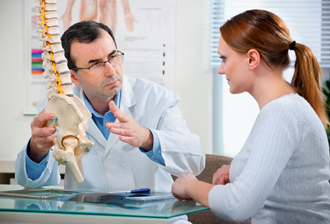
- $ 6,155,000 MEDICAL MALPRACTICE
- $ 2,500,000 MOTOR VEHICLE ACCIDENT
- $ 2,150,000 PREMISES LIABILITY
- $ 2,000,000 MEDICAL MALPRACTICE
- $ 2,000,000 WRONGFUL DEATH
- $ 1,910,000 CONSTRUCTION ACCIDENT
- $ 1,300,000 MOTORCYCLE ACCIDENT
- $ 1,300,000 MOTOR VEHICLE ACCIDENT
- $ 1,250,000 CONSTRUCTION ACCIDENT
Phoenix Lumbar Radiculopathy Injury Lawyer
What is Lumbar Radiculopathy?
Lumbar radiculopathy refers to a disorder of the spinal nerve roots in the lumbar region of the back (L1-L5). It is also a painful disturbance of function or pathologic change in one or more of your nerve roots.
As a result of lumbar radiculopathy, the central gel-like portion of the disc, called the nucleus pulposus, can rupture or herniate through the outer ring of the disc and about the spinal cord or its nerves as they exit the spinal column. Herniation is what causes the commonly recognized pain of sciatica that shoots down the leg through the sciatic nerve.
Symptoms
The following are symptoms of lumbar radiculopathy that can be experienced in your lower back, buttocks, thigh, leg, and/or foot:
- Pain that radiates from the lower back to the buttocks and down to the thigh, leg, and foot
- Muscle weakness
- Burning or tingling feeling
- Feeling of numbness
- Pain that worsens while bending forward or sideways
Common Causes
In lumbar radiculopathy, damage to the disc is the result of outer ring degeneration of the disc (annulus fibrosus) or a traumatic injury, such as:
Consequences
Lumbar radiculopathy will cause pain to the lower region of your back. There may additionally be some pain to the buttocks, thighs, legs, and feet, usually following down the sciatic nerve. This is what is generally referred to as sciatica. It may be difficult for you to do any strenuous or physical activities at work or at home.
Treatment
- Rest
- Stretching and strengthening exercises
- Non Steroidal Anti Inflammatory Drugs (NSAIDs)
- Other stronger medications for pain
- Muscle relaxants
- Epidural injections
If the above does not resolve your pain and discomfort, surgery may be an option. In order to provide pain relief, the surgeon may remove part of your disc or bone (lamina). Bones of the vertebrae may also be fused to alleviate pain.
Contact Us
You can contact the Law Offices of Michael Cordova by calling us at (602) 265-6700, filling out our Case Evaluation Form, or by using our convenient website Chat Services.
Law Offices of Michael Cordova
1700 N 7th St #1, Phoenix, AZ 85006
Phone: 602-265-6700
Hours: Mon - Thurs 8AM - 6PM; Fri 8AM - 5PM



